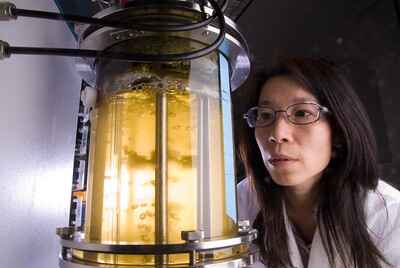3 Types of Biofuels and their Characteristics Explained
Types of biofuels are; first (1st), second (2nd), and third (3rd) generation biofuels respectively. These can also be referred to as the generations of biofuels, they are classified based on source of biomass feedstock, and they differ from the examples of biofuels that include ethanol, biomethane and biodiesel.
Based on phase of occurrence, types of biofuels may also be listed as solid, liquid and gaseous biofuels.
This article discusses the three main types of biofuels, as follows;
1). First Generation Biofuel (as one of the Types of Biofuels)
First (1st) generation biofuel is a type of biofuel that is produced by the direct biochemical conversion of edible organic feedstock.
It is also acceptable to describe first generation biofuel as biofuel derived directly from food crops.
The uniqueness of 1st generation biofuel comes from the fact that its primary feedstock material is not organic waste; but rather freshly-produced, usable biomass.
To produce first generation biofuel, food crops are subjected to biomass conversion processes like fermentation, which cause the molecules of these crops to breakdown and be altered into flammable hydrocarbon compounds like ethanol.
Crops suitable to serve as feedstock for producing first generation biofuel include sugary and starchy crops with lignocellulosic chemical composition, like sugar beet, maize, vegetables, rapeseed and cassava. Animal fat may also be used in some cases.
Examples of first generation biofuels are (bio)ethanol and biodiesel.
First generation ethanol fuel is a volatile and flammable liquid hydrocarbon derived from fermentation of sugary and starchy food materials, and is the most-used form of biofuel globally [8].
Because of their fresh organic primary material (feedstock from which they are produced), first generation biofuels are of generally higher quality, purity, and energy density than other types of biofuels.
However, the development of first generation biofuel is associated with social and economic challenges, that arise from the presence of food insecurity and agricultural land-shortage issues in many regions [5]. These issues affect the long-term sustainability and social acceptability of first generation biofuel.

2). Second Generation Biofuel
Second generation biofuel refers to biofuel that is derived from non-edible, lignocellulosic organic matter, which is usually the residue and inedible parts of food crops.
Another way to describe second generation biofuel, is as biofuel that is produced from the conversion of non-food feedstock, such as agricultural and forest residue [2].
An example of second generation biofuel is bioethanol produced by fermentation of guinea corn and millet husks [6].
The difference between first and second generation biofuels is that first generation biofuel is produced using edible food materials, while second generation biofuels are produced from non-edible food residue [9].
The advantage of second generation biofuel is that its production does not require the use of materials that can serve as food for the population, but rather can serve as a means by which organic waste from farms, forests and industries can be converted to readily-usable bioenergy [1].
Therefore, second generation biofuel production is also a waste-to-energy process while first generation biofuel production is only a biomass conversion process.
It is important to note that the term second generation biofuel is not always limited to fuel from food crop residue, but can sometimes also refer to fuel from all forms of municipal organic waste-feedstock.
The production of this type of biofuel is encourages in some discussions related to sustainable development and energy transition, because it doubles as a pathway for organic waste diversion from landfills and other waste management systems. This implies that the environmental impact of developing and utilizing second generation biofuel is likely to be minimal compared to other types.

3). Third Generation Biofuel (as one of the Types of Biofuels)
Third generation biofuel is a type of biofuel that is produced by the conversion of biomass from photosynthetic microorganisms like bacteria, algae, protists, yeast and filamentous fungi [3].
In some studies, third generation biofuels are made to also include all biofuels produced mostly or solely by the activities of microorganisms.
The advantages of third generation biofuel include low land-demand, non-dependence on food material, rapid growth and significant oil content of microbial biomass [4].
Third generation biofuels have a low carbon footprint because microbial biomass can be continuously regenerated and carbon emissions can be re-absorbed during the growth of this biomass. As a result, microbe-derived biofuel has been studied in multiple cases as a potentially-useful energy resource for mitigating climate change [7].

Conclusion
The three main types of biofuels are;
1. First Generation Biofuel
2. Second Generation Biofuel
3. Third Generation Biofuel
References
1). Hrůzová, K.; Karnaouri, A.; Norén, F.; Rova, U.; Christakopoulos, P. (2020). "Second-Generation Biofuel Production from the Marine Filter Feeder Ciona intestinalis." ACS Sustainable Chemistry & Engineering XXXX(XXX). Available at: https://doi.org/10.1021/acssuschemeng.0c02417. (Accessed 8 March 2023).
2). Kowalski, Z.; Kulczycka, J.; Verhé, R.; Desender, L.; De Clercq, G.; Makara, A.; Generowicz, N.; Harazin, P. (2022). "Second-generation biofuel production from the organic fraction of municipal solid waste." Frontiers in Energy Research 10. Available at: 10.3389/fenrg.2022.919415. (Accessed 8 March 2023).
3). Lackner, M. (2017). "3rd-Generation Biofuels: Bacteria and Algae as Sustainable Producers and Converters." Handbook of Climate Change Mitigation and Adaptation (pp.3173-3210). Available at: https://doi.org/10.1007/978-3-319-14409-2_90. (Accessed 8 March 2023).
4). Maliha, A.; Abu-Hijleh, B. (2022). "A review on the current status and post-pandemic prospects of third-generation biofuels." Energy Syst (2022). Available at: https://doi.org/10.1007/s12667-022-00514-7. (Accessed 8 March 2023).
5). Mohr, A.; Raman, S. (2013). "Lessons from first generation biofuels and implications for the sustainability appraisal of second generation biofuels." Energy Policy. 2013 Dec;63(100):114-122. Available at: https://doi.org/10.1016/j.enpol.2013.08.033. (Accessed 8 March 2023).
6). Oyeleke, S. B.; Ndejio, M. J. (2009). "Production of bioethanol from guinea cornhusk and millet husk." African Journal of Microbiology Research 3(4):147-152. Available at: https://www.researchgate.net/publication/261830573_Production_of_bioethanol_from_guinea_cornhusk_and_millet_husk. (Accessed 8 March 2023).
7). Rafa, N.; Forruque, S.; Badruddin, I. A.; Rahman, M.; Kamangar, S. (2021). "Strategies to Produce Cost-Effective Third-Generation Biofuel From Microalgae." Frontiers in Energy Research. Available at: https://doi.org/10.3389/fenrg.2021.749968. (Accessed 8 March 2023).
8). Rulli, M. C.; Bellomi, D.; Cazzoli, A.; De Carolis, G.; D’Odorico, P. (2016). "The water-land-food nexus of first-generation biofuels." Scientific Reports 6(1):22521. Available at: https://doi.org/10.1038/srep22521. (Accessed 8 March 2023).
9). Sims, R. E.; Mabee, W.; Saddler, J. N.; Taylor, M. (2010). "An overview of second generation biofuel technologies." Bioresour Technol. 2010 Mar;101(6):1570-80. Available at: https://doi.org/10.1016/j.biortech.2009.11.046. (Accessed 8 March 2023).



